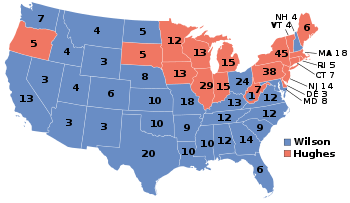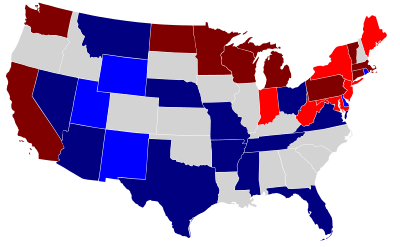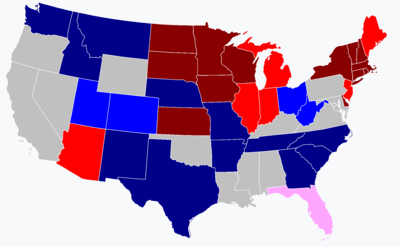1916 United States elections
The 1916 United States elections elected the members of the 65th United States Congress. The election occurred during the Fourth Party System, six months before the United States entered World War I. Unlike 1912, the Democrats did not benefit from a split in the Republican Party, but the Democrats still retained the Presidency and the majority in the Senate. Democrats lost the majority in the House, but retained control of the chamber.
| Presidential election year | |
| Election day | November 7 |
|---|---|
| Incumbent president | Woodrow Wilson (Democratic) |
| Next Congress | 65th |
| Presidential election | |
| Partisan control | Democratic Hold |
| Popular vote margin | Democratic +3.1% |
| Electoral vote | |
| Woodrow Wilson (D) | 277 |
| Charles Evans Hughes (R) | 254 |
  | |
| 1916 presidential election results. Red denotes states won by Hughes, blue denotes states won by Wilson. Numbers indicate the electoral votes won by each candidate. | |
| Senate elections | |
| Overall control | Democratic Hold |
| Seats contested | 35 of 96 seats (32 Class 1 seats + 3 special elections) |
| Net seat change | Republican +2[1] |
 | |
| 1916 Senate results
Democratic gain Democratic hold | |
| House elections | |
| Overall control | Democratic Hold[2] |
| Seats contested | All 435 voting members |
| Net seat change | Republican +19 |
| Gubernatorial elections | |
| Seats contested | 36 |
| Net seat change | Republican +2 |
 | |
| 1916 gubernatorial election results
Democratic gain Democratic hold | |
Democratic President Woodrow Wilson defeated the Republican nominee, former Supreme Court Justice Charles Evans Hughes, in the presidential election.[3] Hughes won the Republican nomination on the third ballot of the 1916 Republican National Convention, defeating several other candidates. Republicans won several Northern states, but Wilson's success in the rest of the country gave him a small margin in the electoral college and the popular vote. Wilson's win made him the first sitting Democratic President to win re-election since Andrew Jackson. Wilson's running mate, Thomas R. Marshall, was the first sitting Vice President to win re-election since John C. Calhoun.
Republicans made moderate gains in the House, gaining a narrow plurality.[4] However, Democrat Champ Clark won re-election as Speaker of the House.
In the second Senate election since the ratification of the 17th Amendment, Republicans made minor gains, but Democrats retained a solid majority.[5]
See also
References
- Republicans picked up one seat in the regularly-scheduled elections and an additional seat in the special elections.
- Democrats lost their House majority in the 1916 elections, but the party retained control of the House through a coalition with minor parties.
- "1916 Presidential Election". The American Presidency Project. Retrieved 25 June 2014.
- "Party Divisions of the House of Representatives". United States House of Representatives. Retrieved 25 June 2014.
- "Party Division in the Senate, 1789-Present". United States Senate. Retrieved 25 June 2014.